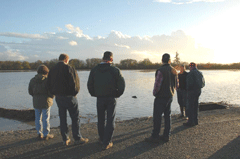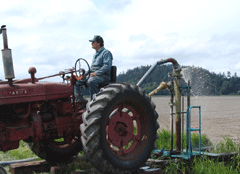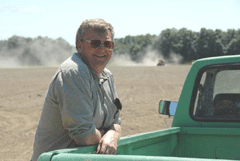Making Room for Shorebirds
Air Date: Week of June 29, 2007

The Nature Conservancy’s Kevin Morse with Skagit County “Farmers for Wildlife” observe natural flooding of the Skagit River. (Photo: Kirsten Morse)
Where rivers meet the sea, shorebirds flock to marshes. But many former marshes have become fertile farmland. Now some farmers in Washington State's Skagit River Valley are working with conservationists and flooding part of their fields to find out if the disappeared shorebirds will return. Deborah Wang of KUOW reports.
Transcript
CURWOOD: It’s Living on Earth. I’m Steve Curwood. The number of birds has been sharply declining in the United States in recent years, and the causes are many. A lot of migrating birds collide with lit buildings at night, and many fall into the clutches of house cats on the loose. Another major problem for birds is the loss of habitat to everything from subdivisions, logging and industrial farming. But in Washington State, farmers and environmental activists are working together in a project to find ways to make more room for birds, specifically migratory shorebirds that require lush, coastal wetlands, by changing the ways that the farmers manage their land. Deborah Wang from member station KUOW in Seattle has the story.
[COW MOOING]
WANG: It’s a busy time of year for farmer Alan Messman. He’s rounding up the last of the cattle to put out on his fields, which are now thick with new grass.
MESSMAN: There are several steers here, three or four, I know there’s one big one over in this bin too.
WANG: It’s a picture perfect setting. The farm, with its turn of the century farmhouse, is located on a delta right at the mouth of the Skagit River. Messman says in the old days, before European settlers arrived, there would have been water under our feet.

Alan Mesman, an organic dairy farmer, prepares to flood one of his fields. (Photo: Kevin Morse)
WANG: In the 1800’s, the settlers built dikes here, and drained the marshes along the Skagit River. What was left was a fine alluvial soil that’s been great for farming. But what was lost were tens of thousands of acres of wetlands. That was a blow to numerous species of wildlife, including shorebirds.
MORSE: The shorebirds are migratory, they fly from South and Central America all the way up to northern Canada, the Arctic, and historically they had lots of good places to stop and feed.
WANG: Kevin Morse is with the environmental group The Nature Conservancy. He says the loss of habitat all along the West Coast has led to a decline in 14 species of shorebirds. That’s a difficult problem to solve in areas that are heavily developed.

The Nature Conservancy’s Kevin Morse with Skagit County “Farmers for Wildlife” observe natural flooding of the Skagit River. (Photo: Kirsten Morse)
MORSE: Historically there was a patchwork of freshwater wetlands here, now we don’t have it, and now we have to be innovative and figure out how can we create that environment in the context of what is happening here.
WANG: So, The Nature Conservancy devised an elaborate experiment to see whether farmers could help bring shorebirds back. They guessed that even small pieces of wetlands scattered around the Skagit Delta could have a big impact. So they began looking for farmers who’d be willing to create new wetlands by flooding a portion of their land. They would compare the flooded fields with land that is grazed and land that is left alone.
The Nature Conservancy sweetened the deal by offering to pay rent for the land. And, at the end of the three year project, it would be chemical free and eligible for organic certification. Three farmers agreed to become the project’s guinea pigs, including dairy farmer Alan Messman.

Hedlin Farm Field being flooded. (Photo: Kevin Morse)
[GAS PUMP STARTING]
Now Messman is doing something previously unimaginable, he’s purposely flooding his fields. A makeshift pump draws fresh water from an irrigation ditch it spurts out from a pipe onto the dry ground. Scientists think that flooding will not only attract birds, but could make the soil more fertile as well. Messman isn’t so sure and the whole process makes him slightly uncomfortable.
MESSMAN: It seems odd to be pumping water on a field, you know when we spend our whole life pumping water off the fields. So, yeah, it’s different.
JONES: And in this close-knit farming community, there are skeptics. Farmers here have long been suspicious of conservationists. The two groups have fought bitterly over salmon restoration and other land use issues. Serena Campbell and her husband Dave sit at a picnic table by their century-old farmhouse. A dike behind them keeps the waters at bay. Campbell says they decided to join the project to prove that farming and conservation could coexist.

Dave Hedlin at the Thein Field during seeding (Photo: Kirsten Morse)
CAMPBELL: You have to kind of make a template that works, and part of that working is making the economics of it work, and once that’s in place, other people in community kind of lose their fear of what’s happened. We haven’t died doing this, and there weren’t any unexpected boogeymen.
JONES: If enough farmers lose their fear, the goal is to create a rotating patchwork of quality habitat for migrating shorebirds.
[BIRD AMBIENCE]
JONES: And if they are lucky, it could end up looking something like this. A few miles from the Skagit Delta sits a former potato field on the edge of a beautiful bay. The Nature Conservancy purchased the property in 2001, and then turned off the pump that kept the field dry.
Program Director Bob Carey says he was amazed by how quickly the wetlands returned.
KERRY: Within literally months, we saw shorebirds and waterfowl starting to show up here. Within a couple years, pretty spectacular diversity.
JONES: Now, Wilson’s phalaropes, dunlin and other shorebirds are frequent visitors along with snow geese, wood ducks, and great blue herons.
BIRD WATCHER: Moving left to right… there she goes.
JONES: And it may not take long for the shorebirds to return to the Skagit Delta either. Scientists there will be watching when the shorebirds pass through on their annual migrations at the end of the summer.
For living on earth, I’m Deborah Wang on Port Susan Bay, Washington.
Links
Nature Conservancy “Farming for Wildlife” Homepage
Skagitonians to Preserve Farmland, a farmers’ conservation group
Living on Earth wants to hear from you!
Living on Earth
62 Calef Highway, Suite 212
Lee, NH 03861
Telephone: 617-287-4121
E-mail: comments@loe.org
Newsletter [Click here]
Donate to Living on Earth!
Living on Earth is an independent media program and relies entirely on contributions from listeners and institutions supporting public service. Please donate now to preserve an independent environmental voice.
NewsletterLiving on Earth offers a weekly delivery of the show's rundown to your mailbox. Sign up for our newsletter today!
 Sailors For The Sea: Be the change you want to sea.
Sailors For The Sea: Be the change you want to sea.
 The Grantham Foundation for the Protection of the Environment: Committed to protecting and improving the health of the global environment.
The Grantham Foundation for the Protection of the Environment: Committed to protecting and improving the health of the global environment.
 Contribute to Living on Earth and receive, as our gift to you, an archival print of one of Mark Seth Lender's extraordinary wildlife photographs. Follow the link to see Mark's current collection of photographs.
Contribute to Living on Earth and receive, as our gift to you, an archival print of one of Mark Seth Lender's extraordinary wildlife photographs. Follow the link to see Mark's current collection of photographs.
 Buy a signed copy of Mark Seth Lender's book Smeagull the Seagull & support Living on Earth
Buy a signed copy of Mark Seth Lender's book Smeagull the Seagull & support Living on Earth

